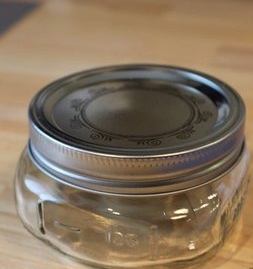Whenever you find a sale on butter, don’t be afraid to go ahead and stock up. You can freeze butter and you can home-can it. Canned butter lasts for years if the seals are not disturbed and you keep it in a cool place. I’ve canned butter for years and here is my method.
I’ve always pressure canned butter instead of water-bathing it. Butter is dairy of course and non-acidic so if you water bath it, you really do run the risk of botulism. Oh, but canning butter is easy, and you should try it.
My favorite type of jars to use for canning butter are half pint, wide-mouth jars.
The wide mouth makes it easier to get the butter out of the jars and opening a half pint at a time is convenient for most families. But don’t give up if you can’t find these types of jars. I used regular half pint jelly jars this time and they work just fine.
I used 5 pounds of butter and got 10 half pints.
You will need to know how to use a pressure canner to use these directions.
You’ll need:
10-12 half pint jars, lids and rings
jar lifter and lid magnet or tongs
plastic jar funnel
small dish of vinegar
several clean cloths
pressure canner and some knowledge of its use
pot for melting and boiling the butter
a ladle
pan for heating lids and rings
oven – set to 275* F – This is for heating the jars. You don’t have to heat your jars in the oven, but if you use water, you will need to dry out the jars before adding the melted butter. That’s kind of a pain. So put your jars in a 9×13 casserole pan and put them in the oven set to 275*F for about 20 minutes before adding the butter.
Go ahead and put 3-4 inches of water in your pressure canner and bring up the heat.
Put water in the pan to heat lid and rings, go ahead and bring the heat up under that as well.
Put the butter in a pot and melt it, bring it to a boil then reduce the heat to a simmer. Let the butter simmer for 10 minutes or so. You’re evaporating some of the moisture from the butter and getting it good and hot. Be sure to stir it and don’t allow any of the milk solids ( the little while particles) to burn and don’t let it boil over!
Once everything is good and hot, carefully take the pan of jars out of the oven. Place the jars right side up on a clean dish cloth. Insert the plastic funnel in the jars one at a time and fill the jars with hot butter, leaving a 1/2″ head space.
Using a clean cloth dipped in vinegar and then squeezed out, clean off the jar rims.
Place lids and rings on each jar, tighten the rings just firmly but not hard.
Put the jars in the pressure canner that has 3-4 inches of hot water in it. I put in a couple of strategically placed clean dish cloths in case the little jars topple over. They can rattle against the sides and each other and break.
Put the lid on the canner and fasten it down. Allow steam to flow out of the vent for about 10 minutes. Place the weight (at 10 pounds) or gauge (11 pounds) on the vent and when it reaches the correct pressure (when the weight begins to rattle) start timing.
Allow the pressure canner to chug along for 60 minutes for these half pints.
After 60 minutes, take the canner of the heat and allow it to release its pressure naturally. You might hear the lids sealing while the jars are still in the canner, that’s OK.
Once all the pressure is gone and you can safely open the canner, open it up and take the jars out of the canner. Place them on a clean towel to cool.
Because this is pressure canned, and the butter is subjected to high temperatures, you may see the milk solids clump together and fall to the bottom of the jar. That’s OK! Jut give your jars a shake as they cool to combine the solids and the liquids. As the butter solidifies, the solids will be dispersed throughout the liquids and it will look like you expect butter to look.
Check for seals after it cools. Store canned butter in a dark cool place. If you want the butter to be firm, then refrigerate a jar before you open it.




32 Comments